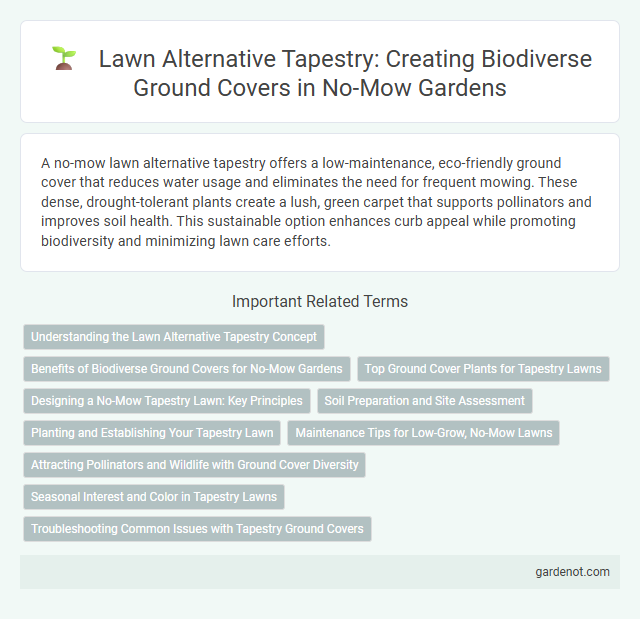A no-mow lawn alternative tapestry offers a low-maintenance, eco-friendly ground cover that reduces water usage and eliminates the need for frequent mowing. These dense, drought-tolerant plants create a lush, green carpet that supports pollinators and improves soil health. This sustainable option enhances curb appeal while promoting biodiversity and minimizing lawn care efforts.
Understanding the Lawn Alternative Tapestry Concept
Lawn alternative tapestry involves using diverse, low-maintenance ground cover plants that replace traditional grass lawns, enhancing biodiversity and reducing water and mowing needs. This concept emphasizes native species selection to create resilient, eco-friendly landscapes that support pollinators and soil health. Incorporating perennial herbs, clover, and ornamental grasses forms a sustainable tapestry that thrives with minimal intervention.
Benefits of Biodiverse Ground Covers for No-Mow Gardens
Biodiverse ground covers in no-mow gardens enhance soil health by promoting microbial activity and preventing erosion. These tapestry alternatives reduce water usage and minimize maintenance while supporting local pollinators and beneficial insects. Incorporating a variety of native species ensures year-round visual interest and resilience against pests and diseases.
Top Ground Cover Plants for Tapestry Lawns
Creeping thyme, sedum, and clover are top ground cover plants for tapestry lawns due to their low maintenance and drought tolerance. These species create a dense, weed-resistant carpet that reduces mowing frequency, conserves water, and enhances soil health. Incorporating native varieties promotes biodiversity, supports pollinators, and adapts well to local climate conditions, making them ideal choices for no-mow lawn alternatives.
Designing a No-Mow Tapestry Lawn: Key Principles
Designing a no-mow tapestry lawn involves selecting diverse, low-maintenance ground covers such as clover, creeping thyme, and moss to create a lush, eco-friendly landscape that reduces water and fertilizer use. Emphasizing plant diversity ensures seasonal color variation and resilience against pests and diseases, while careful soil preparation and proper irrigation establish healthy growth without frequent mowing. Incorporating native species adaptable to local climate conditions enhances sustainability and supports local pollinators, making the no-mow tapestry lawn both visually appealing and environmentally beneficial.
Soil Preparation and Site Assessment
Effective soil preparation and thorough site assessment are crucial for establishing a no-mow lawn tapestry. Begin by testing soil pH and nutrient levels to tailor amendments that optimize plant health, while removing existing vegetation to reduce competition. Evaluating sunlight exposure and drainage patterns ensures selecting appropriate groundcover species that thrive in specific microclimates and soil conditions.
Planting and Establishing Your Tapestry Lawn
Plant a no-mow lawn tapestry by selecting low-maintenance, drought-resistant ground covers such as creeping thyme, clover, or sedum, which thrive in various soil types and climates. Prepare the soil by removing existing grass and weeds, then enrich it with organic compost for optimal root development and moisture retention. Establish your tapestry lawn through direct seeding or installing plugs, ensuring consistent watering until plants are well-rooted and self-sustaining.
Maintenance Tips for Low-Grow, No-Mow Lawns
Low-grow, no-mow lawn alternatives like clover, creeping thyme, and sedum require minimal maintenance focused on occasional watering during dry spells and periodic trimming to prevent overgrowth. Applying organic mulch helps retain soil moisture and suppress weeds, reducing the need for chemical interventions. Regular monitoring for pests and diseases ensures a healthy tapestry without disrupting its natural low-maintenance benefits.
Attracting Pollinators and Wildlife with Ground Cover Diversity
Lawn alternative tapestry featuring diverse ground cover plants attracts pollinators such as bees, butterflies, and hummingbirds by providing nectar-rich flowers throughout the growing season. Native species like clover, creeping thyme, and wild strawberries enhance biodiversity, supporting beneficial insects and small wildlife that contribute to ecosystem health. This approach reduces maintenance while promoting a resilient, vibrant habitat, outperforming traditional grass lawns in ecological value.
Seasonal Interest and Color in Tapestry Lawns
Tapestry lawns feature diverse plant species that provide vibrant seasonal interest and dynamic color palettes throughout the year. Native wildflowers and drought-resistant grasses contribute to varying hues from spring blooms to autumnal shades. This mosaic of textures and colors enhances biodiversity while reducing maintenance compared to traditional lawns.
Troubleshooting Common Issues with Tapestry Ground Covers
Tapestry ground covers offer an eco-friendly, low-maintenance alternative to traditional no-mow lawns but can encounter issues like patchy growth, discoloration, and pest infestations. Repairing patchy areas requires reseeding or layering new tapestry plants, while discoloration often results from improper watering or soil nutrient imbalances that can be corrected with soil testing and adjusted irrigation. Pest problems such as aphids or fungal infections benefit from organic insecticides and improved air circulation to restore the tapestry's vibrant, healthy appearance.
Lawn alternative tapestry Infographic

 gardenot.com
gardenot.com